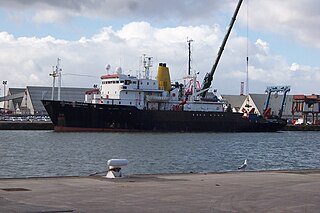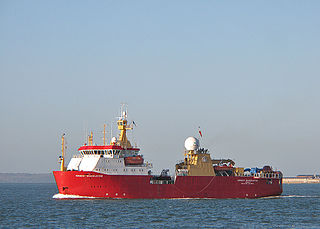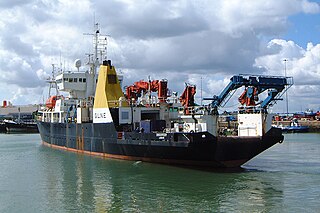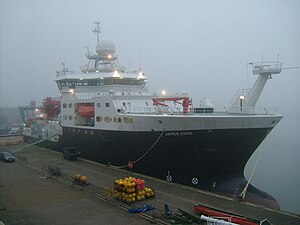
The Challenger expedition of 1872–1876 was a scientific programme that made many discoveries to lay the foundation of oceanography. The expedition was named after the naval vessel that undertook the trip, HMS Challenger.

RRS Discovery is a barque-rigged auxiliary steamship built in Dundee, Scotland for Antarctic research. Launched in 1901, she was the last traditional wooden three-masted ship to be built in the United Kingdom. Her first mission was the British National Antarctic Expedition, carrying Robert Falcon Scott and Ernest Shackleton on their first, and highly successful, journey to the Antarctic, known as the Discovery Expedition.

The Cayman Trough is a complex transform fault zone pull-apart basin which contains a small spreading ridge, the Mid-Cayman Rise, on the floor of the western Caribbean Sea between Jamaica and the Cayman Islands. It is the deepest point in the Caribbean Sea and forms part of the tectonic boundary between the North American Plate and the Caribbean Plate. It extends from the Windward Passage, going south of the Sierra Maestra of Cuba toward Guatemala. The transform fault continues onshore as the Polochic-Motagua fault system, which consists of the Polochic and Motagua faults. This system continues on until the Chiapas massif where it is part of the diffuse triple junction of the North American, Caribbean and Cocos plates.

HMS Challenger was a Pearl-class corvette of the Royal Navy launched on 13 February 1858 at the Woolwich Dockyard. She served the flagship of the Australia Station between 1866 and 1870.

The National Oceanography Centre Southampton (NOCS) is a centre for research, teaching, and technology development in Ocean and Earth science. NOCS was created in 1995, jointly between the University of Southampton and the UK Natural Environment Research Council and is located within the port of Southampton at a purpose-built dockside campus with modern facilities. In 2010 the university and NERC components demerged, and the NERC-managed component became the National Oceanography Centre. The two components of NOCS continue close collaboration through the jointly run Graduate School, shared research facilities and laboratories, complementary research groups, and many joint research grants and publications. The university component “Ocean and Earth Science, National Oceanography Centre Southampton” (OES) is part of the Faculty of Environmental and Life Sciences, (FELS). It was ranked 46th in the world for Earth and Marine Sciences by the QS World University Rankings in 2019.
The National Oceanography Centre (NOC) is a marine science research and technology institution based across two sites, one in Southampton and one in Liverpool, England. It is the UK’s largest institution for integrated sea level science, coastal and deep ocean research and technology development. The Centre was established to promote co-operation with institutions across the UK marine science community, to better address key issues including sea level change, the ocean's role in climate change, computer simulation of the ocean's behaviour, and the long term monitoring and future of the Arctic Circle.

The RRS Charles Darwin was a Royal Research Ship belonging to the British Natural Environment Research Council. Since 2006, she has been the geophysical survey vessel, RV Ocean Researcher,
A Royal Research Ship (RRS) is a merchant navy vessel of the United Kingdom that conducts scientific research for His Majesty's Government. Organisations operating such ships include; the Natural Environment Research Council (NERC), the British Antarctic Survey (BAS) and the National Oceanography Centre (NOC). A warrant from the monarch is required before a ship can be designated as an RRS.

Laura Bassi is an icebreaking research vessel operated by the Italian National Institute for Oceanography and Applied Geophysics,. In February 2023, she set a record by sailing further south than any ship before, achieving 78°44•280´S in the Bay of Whales, which was made possible by an unusual lack of ice. Between 1999 and 2019, she was the British Antarctic Survey (BAS) logistics ship, primarily used for the resupply of scientific stations in the Antarctic.
The British Antarctic Survey (BAS) is the United Kingdom's national polar research institute. It has a dual purpose, to conduct polar science, enabling better understanding of global issues, and to provide an active presence in the Antarctic on behalf of the UK. It is part of the Natural Environment Research Council (NERC). With over 400 staff, BAS takes an active role in Antarctic affairs, operating five research stations, one ship and five aircraft in both polar regions, as well as addressing key global and regional issues. This involves joint research projects with over 40 UK universities and more than 120 national and international collaborations.

The Discovery Investigations were a series of scientific cruises and shore-based investigations into the biology of whales in the Southern Ocean. They were funded by the British Colonial Office and organised by the Discovery Committee in London, which was formed in 1918. They were intended to provide the scientific background to stock management of the commercial Antarctic whale fishery.

RRS Discovery was a British Royal Research Ship operated by Natural Environment Research Council (NERC).

The British Oceanographic Data Centre (BODC) is a national facility in the United Kingdom that collects and distributes marine environmental data. It serves as the designated marine science data centre for the UK and is part of the National Oceanography Centre (NOC). Most of its operations are conducted at its Liverpool facility, with a smaller team based in Southampton. The BODC supports science, education, industry, and the general public by providing access to comprehensive marine data.

RRS Shackleton was a Royal Research Ship operated by the British scientific research organisations the Falkland Islands Dependencies Survey (FIDS), British Antarctic Survey (BAS) and Natural Environment Research Council (NERC) in the Antarctic from 1955 to 1983. She was subsequently operated as a seismic survey vessel under the names Geotek Beta, Profiler and finally Sea Profiler before being scrapped in 2011.

RRS William Scoresby was British Royal Research Ship built for operations in Antarctic waters. Specially built for the Discovery Committee by Cook, Welton & Gemmell of Beverley, the ship was launched on 31 December 1925, and named after the noted 19th-century Arctic explorer, scientist and clergyman. Over the next 12 years the ship made seven voyages into Antarctic waters as part of the Discovery Investigations, accompanied by the ship Discovery until 1929, and then by Discovery II. During this time she marked about 3,000 whales and completed biological, hydrographical and oceanographic studies. She also took part in the 2nd Wilkins-Hearst Antarctic Expedition in 1929-1930, launching a Lockheed Vega floatplane for flights over Antarctica.
RRS Discovery II was a British Royal Research Ship which, during her operational lifetime of about 30 years, carried out considerable hydrographical and marine biological survey work in Antarctic waters and the Southern Ocean in the course of the Discovery Investigations research program. Built in Port Glasgow, launched in 1928 and completed in 1929, she was the first purpose-built oceanographic research vessel and was named after Robert Falcon Scott's 1901 ship, RRS Discovery.

RRS Discovery is a Royal Research Ship operated by the Natural Environment Research Council. The ship is the third such vessel to be built and named for the ship used by Robert Falcon Scott in his 1901-1904 expedition to the Antarctic.

The Beebe Hydrothermal Vent Field is the world's deepest known hydrothermal vent site and is located just south of Grand Cayman in the Caribbean, on the north side of the Mid-Cayman Spreading Centre in the Cayman Trough. Approximately 24 kilometres (15 mi) south of Beebe is the Von Damm Vent Field.

The British Mid-Ocean Ridge Initiative was a multidisciplinary scientific investigation of the creation of the Earth's crust in the deep oceans. It was funded by the UK's Natural Environment Research Council (NERC) from 1993 to 1999.

Boaty McBoatface is part of a fleet of six 'over the horizon' autonomous underwater vehicles (AUVs) of the Autosub Long Range (ALR) class. Launched in 2011 the ALRs are designed, owned and operated by the National Oceanography Centre in the UK. One of the many features of the ALRs is the shore-launch capability.

















